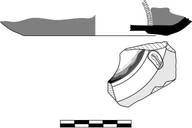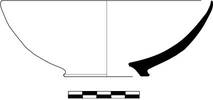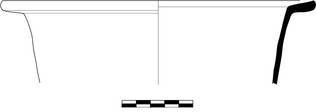Greek, Roman and Byzantine Pottery at Ilion (Troia):
Sebastian Heath and Billur Tekkök, Editors
Pit K/L16/17.0120
Please note that this is a public draft of work in progress
1. Eastern Sigillata A Hayes form 12 Base (40 BC to AD 10)
P. H. .015. Est. diam. base .011 (1/5 preserved). Th. .004.
K/L16/17.0120:7. Single sherd. Compact pale (10YR 8/3) fabric. Dark red (10R 4/6) slip partially preserved on all extant surfaces. Two bands of rouletting on floor. Spacer mark on base.
tavola II, no. 10.
svg/K-L16-17.0120-7.jpg
2. Eastern Sigillata Bi Hayes Form 35 (mid 1st century AD)
H. .038. Est. diam. rim .086 (1/10 preserved). Th. .004.
K/L16/17.0120:5. Single sherd. Micaceous, very fine, brown (2.5YR 6/8) fabric. Flaking deep brown (2.5YR 4/8) slip on all surfaces, thicker under short rim.
, p. 60, tavola XIII.5.
svg/K-L16-17.0120-5.jpg
3. Çandarli Loeschke Form 6 Profile (Late first to Second AD)
H. .024. Est. diam. rim .10 (1/10 preserved). Th. .005.
K/L16/17.0120:1. Compact light red fabric (2.5YR 6/6) with very few inclusions, occasional tiny micaceous flakes in direct sunlight. Thick well-smoothed orange (near 2.5YR 5/8) slip on interior, thin to almost plain on exterior.
p. 75 and pl. XVII.1.
svg/K-L16-17.0120-1.jpg
4. Çandarli Loeschke Form 6 Base (50-100)
P. H. .011. Th. .004.
K/L16/17.0120:17. Single sherd. Fine light red fabric (2.5YR 6/6) with rare miniscule inclusions. Thick lustrous orange (near 2.5YR 5/8) slip, smoothed on interior, slightly thinner and less well smoothed on exterior.
svg/K-L16-17.0120-17.jpg
5. Çandarli Loeschke Form 9 Base (First to Second AD)
P. H. .014. Th. .006.
K/L16/17.0120:12. Single sherd with part of floor and wall. Compact red fabric (10R 5/8) with few tiny white inclusions. Dark red (10R 4/6) slip on interior and exterior, worn in places.
p. 76 and fig. XVII.2.
svg/K-L16-17.0120-12.jpg
6. Çandarli Loeschke Form 20 Bowl Rim
P. H. .019. Est. diam. rim near .12 (<1/20 preserved). Th. .006.
K/L16/17.0120:2. Single sherd. Fine red (5YR 7/6) fabric, showing mix of redder and yellower grains. Red slip (2.5YR 5/8) on all surfaces. Brush marks on interior, smoothing bands on exterior.
svg/K-L16-17.0120-2.jpg
7. “Bright Orange” Candarli Loeschke Form 26a Bowl (50-100)
P. H. .020. Est. diam. rim .10 (<1/20 preserved). Th. .003.
K/L16/17.0120:3. Single sherd, wall to initiation of floor. Fine orange fabric (2.5YR 7/6), bright orange (near 10R 5/8) slip on all surfaces. Scratches on exterior. Groove under exterior rim.
svg/K-L16-17.0120-3.jpg
8. Çandarli Loeshcke Form 26a Bowl Base (50-100)
P. H. .05. Est. diam. base .10 (<1/20 preserved). Th. .009.
K/L16/17.0120:4. Single sherd. Fine fabric, pale pink (5YR 6/8) with occasional darker inclusions. Dark red slip (2.5YR 4/8) slip on all surfaces. Incised concentric circles on interior floor above base. A shallow offset indicates that the floor was smoothed with a broad tool whereas the walls show brush marks. High quality slip for ware.
svg/K-L16-17.0120-4.jpg
9. Unclassified Late Hellenisti/Early Roman Red Slip Plate
P. H. .021. Est. diam. base .14 (<1/10 preserved). Th. .004.
K/L16/17.0120:19. Single base sherd with ring foot and part of sloping floor. Fine light brown (7.5YR 6/4) with very few tiny inclusions. The pattern of firing on the interior floor is distinctive,. A central area is dark red (near 10R 2.5/1). A thinner ring, presumably the trace of the base of the next vessel in the stack, is a lighter red (2.5YR 4/8), whereas the outermost preserved ring is an intermediate brown (2.5YR 4/4). None of these colors is very consistent with outermost band showing the most variability. The exterior is generally brown (2.5YR 4/4) but is lighter in patches where the slip is thinner. The underside of the ring foot is almost unslipped.
svg/K-L16-17.0120-19.jpg
10. Unclassified Late Hellenistic/Early Roman Red Slip Bowl
P. H. .013. Est. diam. base .041 (completely preserved). Th. .003.
K/L16/17.0120:18. Single sherd with entire base and lower wall. Fine reddish brown (10R 6/8) somewhat micaceous fabric with occasional tiny light and other inclusions. Preserved interior surface entirely covered with dark red (10R 4/8) slip which is somewhat smoothed and distinct from fabric. Exterior is unevenly slipped with most of underside plain. Floor of vessel bears stamped decoration, four 10-leaf palmettes from somewhat crude stamp, surrounded by a single preserved band of fine rouletting.
svg/K-L16-17.0120-18.jpg
11. Unclassified/Regional Thin-wall Cup/Jug
P. H. .063. Est. diam. rim .07 (<1/20 preserved). Th. .0015.
K/L16/17.0120:10. Single sherd with rim and handle. Fine reddish brown (10R 5/8) fabric with occasional angular white inclusions. Surface weak red/gray (near 2.5YR 5/3). From a first century AD pit.
Near , nos. 50 and 51.
svg/K-L16-17.0120-10.jpg
12. Unclassified Thin-wall Cup/Jug Base, "Orange over Gray Core"
P. H. .017. Est. diam. base .04 (1/3 preserved). Th. .004.
K/L16/17.0120:9. Gray core (2.5Y 3/1); very thin, orange (2.5YR 5/8) surface. Hard, compact fabric. Frequent small white inclusions occurring more often than in regional examples. Scratches on exterior surface. This is near the variant with the “thin orange layer on gray core”.
svg/K-L16-17.0120-9.jpg
13. Plain Ware Jug Rim (Roman)
P. H. .04. Est. diam. rim .11 (1/4 preserved). Th. .005.
K/L16/17.0120:16. Single sherd with rim and upper part of neck. Light red (2.5YR 6/6) fabric with occasional lime chunks and frequent tiny light bits. Surface lightly slipped buff (near 7.5YR 7/3).
Cf. “Light Brown Fabric”. Cf. , no. 94.
svg/K-L16-17.0120-16.jpg
14. Plain Ware Bowl Profile (Early Roman)
H. .55. Est. diam. rim .16 (<1/20 preserved). Est. diam. base .06 (1/3 preserved). Th. .007.
K/L16/17.0120:11. Single sherd preserving profile. Fabric is fired brown (5YR 6/8). The inclusions are varied, consisting of .001 lime chunks, some visible on surface, angular quartz, and sub-angular stones, and varied tiny bits. There are occasional small voids. Surfaces smoothed with some scratches and surface voids. A simple form with similarities to red-slipped tablewares such as ESA Hayes 22.
svg/K-L16-17.0120-11.jpg
15. Phocaean Cookpot, Flaring Rim (Early Roman)
P. H. .058. Est. diam. rim .22 (1/10 preserved). Th. .003.
K/L16/17.0120:13. Two joining rim sherds. Slightly granular brown (5YR 4/4) fabric with frequent angular white inclusions and occasional golden mica flattened on surface. Surface dark gray (2.5Y 4/1) with much thinner slip on lower part of preserved exterior. Shallow, broad ridges on exterior.
For form see no. 80.
svg/K-L16-17.0120-13.jpg
16. Baking Pan, Phocaean
P. H. .029. Est. diam. rim .26 (<1/10 preserved). Th. .008.
K/L16/17.0120:15. Single rim sherd with upper wall. Coarse light brown (7.5YR 6/4) fabric with added sand and varied smaller inclusions, occasional small golden mica visible on surface. The exterior surface is burned black and this discoloring intrudes into the fabric. Interior surface is unslipped but the top of the rim carries thin gray wash.
Same rim form also in Phocaean fabric at , no. 91.
svg/K-L16-17.0120-15.jpg
17. Gritty Gray Cookpot (Early Roman)
P. H. .039. Est. diam. rim .16 (1/12 preserved). Th. .0057.
K/L16/17.0120:21. Single rim sherd, with upper wall. Gray (2.5YR 5/1) farbic with distinct redder (2.5YR 6/6) layering in thickened rim. Angular quartz inclusions and frequent lighter bits.
Similar form at no. 78 and no. 111.
svg/K-L16-17.0120-21.jpg
















